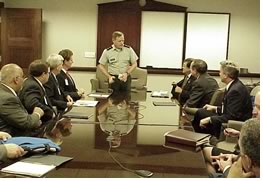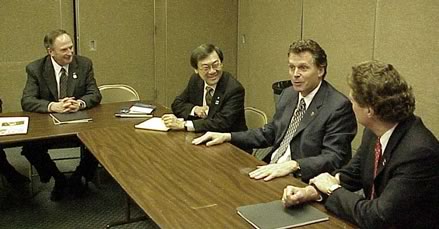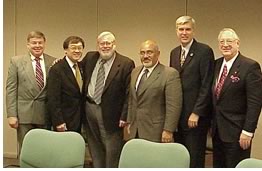
Government Affairs Day meetings highlight Institute's unity of purpose
Packing a week's worth of high-level networking into an afternoon's time, the AIA Executive Committee crisscrossed federal Washington February 28 to advance the AIA's positions on design for security, energy-efficient buildings, school modernization, and the value of private-sector architects working with public-sector clients.
As with all of the AIA component leaders traveling to Capitol Hill for the Grassroots Government Affairs Day, the national AIA elected officers and senior staff carried the pins designed by Grassroots Chair and First Vice President Thompson E. Penney, FAIA, and a message of AIA unity of purpose.
 U.S.
Army Corps of Engineers: At the U.S. Corps of Engineers headquarters,
AIA President Gordon H. Chong, AIA, impressed Major General Hans Van Winkle,
deputy chief engineer, with the message that architects do more than design
buildings. Van Winkle enumerated the challenges currently before the Corps—change
the perception of its work from "man against nature" to "man
working with nature," shore up an aging infrastructure of bases,
and maintain the historic flavor and architectural character of military
facilities within a tight budget. When the Corps is engaged in strategic
planning, remember the full extent of architect talent, Chong reminded
the general: land-use and strategic planning for sustainability, life-cycle
and energy cost analysis, and interdisciplinary coordination and synthesis.
When you think about architects, think beyond buildings, Chong told Van
Winkle.
U.S.
Army Corps of Engineers: At the U.S. Corps of Engineers headquarters,
AIA President Gordon H. Chong, AIA, impressed Major General Hans Van Winkle,
deputy chief engineer, with the message that architects do more than design
buildings. Van Winkle enumerated the challenges currently before the Corps—change
the perception of its work from "man against nature" to "man
working with nature," shore up an aging infrastructure of bases,
and maintain the historic flavor and architectural character of military
facilities within a tight budget. When the Corps is engaged in strategic
planning, remember the full extent of architect talent, Chong reminded
the general: land-use and strategic planning for sustainability, life-cycle
and energy cost analysis, and interdisciplinary coordination and synthesis.
When you think about architects, think beyond buildings, Chong told Van
Winkle.
Democratic National Committee: The Democratic National Committee was the next stop to meet its chair, the legendary fundraiser Terry McAuliffe. The AIA is responsibly bipartisan, AIA COO Jim Dinegar reminded McAuliffe when he asked with good humor whether all present were registered Democrats. The DNC chair talked enthusiastically of his party's updated computerized database of registered voters nationwide, redistricting activities, plans for construction of a new headquarters facility, and chances for upcoming elections. McAuliffe reacted positively to Chong's message of school construction and community development and provided contacts for the AIA to work productively on those issues with his party.

U.S. Department of Energy: Department of Energy Deputy Assistant Secretary Mark Ginsberg received the AIA's message with enthusiasm. Ginsberg, whose staff has worked with the AIA Committee on the Environment for years, has a progressive vision for building efficiency. People set goals of 20 or 30 percent increases in energy efficiency, he said. That's not enough. "The goal I would like to set is 120 percent more efficiency" where buildings use photovoltaics and advanced energy-efficient designs so that they contribute to the local electrical grid rather than draw from it," he said.
 Too
often architects say "The client didn't ask for energy efficiency,"
Ginsberg added.. "I always ask, 'Did you offer it?'"
Too
often architects say "The client didn't ask for energy efficiency,"
Ginsberg added.. "I always ask, 'Did you offer it?'"
He also has an abiding interest in energy-efficient school construction. Portable classrooms got particular attention. "Portable classrooms are neither portable nor efficient and often end up being junk."
Chong raised the possibility of an ongoing research initiative between the AIA and Department of Energy. Ginsberg was warm to the proposal and mentioned his department's current move from researching the performance of components to research on systems integration. Funding for such research is down $10 million (almost 15 percent) this year, he said. The department is always looking for showcases where the community is involved in energy-efficiency programs, he added.
U.S. Conference of Mayors: The Executive Committee split into two groups to be able to cover the last two visits of the day to the U.S. Conference of Mayors and the General Services Administration. Penney and Conference of Mayors Director Dave Gatton discussed the conference's summer meeting on security to be held in Madison, Wis.; its Business Council on Reinvestment in America's Cities, of which the AIA is a founding member; and progress with the Mayors Institute on City Design, administered by the Conference of Mayors and the American Architectural Foundation.
General Services
Administration: GSA Public Buildings Service Deputy Commissioner
Paul E. Chistolini and Chief Architect Edward A. Feiner, FAIA, continued
discussions ongoing with the AIA since September on building security.
Among the topics:
• Terrorism insurance is making leasing more difficult because actuaries
haven't calculated the risk/cost ratios yet. This will be a big issue
in the coming year, Feiner predicts. (Currently GSA oversees 160 million
square feet of leased space and 180 million square feet of government-owned
space, with a long-range plan for increasing ownership.)
• There is a demand for more border stations now, particularly along
the northern U.S. border.
• The research agenda for building-security guidelines has not yet
been set. Because the levels of threat are significantly different among
armed-services, Department of State, and GSA-administered facilities,
there is never likely to be a single security guideline, but there is
demand for a more publicly available set of standards, Feiner said.
• GSA is conducting design excellence workshops to increase opportunities
for more firms to compete for GSA work. The workshops also bring together
procurement officials, designers, and building users to generate broader
understanding of the many different approaches to design for building
security. (Monitor the AIA
building security through design Web site for dates and times as they
become available.)
Copyright 2002 The American Institute of Architects. All rights reserved.
![]()
|
Photos by Douglas E. Gordon, Hon. AIA. |
|